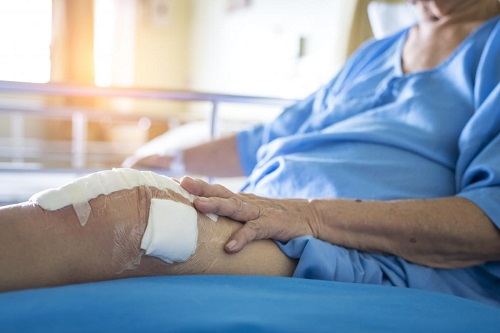- Home
- Knee Surgery
- Knee Replacements
- Partial Knee Replacements
- Common Problems
Common Problems After
Knee Replacement
Written By: Chloe Wilson, BSc(Hons) Physiotherapy
Reviewed by: KPE Medical Review Board

Problems after knee replacement surgery are usually fairly mild and short lived, particularly with partial knee replacements.
People are usually up and around within a few days and make a quick recovery.
But, with any surgery, there are risks and possible complications. Knee replacements are no exception.
Here we will look at the general risks of any surgery and the specific risks and long term problems that can be associated with partial knee replacements. If you have had a total knee replacement, visit the TKR problems/risks section instead.
Partial Knee Replacement Problems
Generally, people recover really well after partial knee replacement surgery. They are up out of bed walking around the next day and usually regain full range of movement and strength. Crutches or sticks may be needed for the first few days for some support.
It may be painful for the first few days after a partial knee replacement, but people often find the knee pain is actually less severe than beforehand as they no longer have the arthritis pain.
There may be persistent numbness around the scar after knee replacement. This is due to some of the small nerve fibres being disrupted during the surgery, but this is usually minor and often recovers with time.
General Risks of Surgery
With any surgery, there are risks but they are extremely rare. These risks include:

- Bleeding: at the operation site. Minor bleeding is normal, but if it doesn't settle down it may indicate there is a problem
- Blood Clots: which can break off and travel around the body occasionally causing a stroke or heart attack
- Infection: usually at the site but the infection can spread around your body.
Risks for anesthesia include breathing problems and reactions to the medications.
Your surgeon will discuss all of these with your prior to your surgery. If you have any questions, always ask your doctor until you are happy that you understand what exactly is involved.
Short Term Problems After Knee Replacement
Specific problems after partial knee replacement surgery are rare but may include:
- Swelling: around the knee joint. You can help to reduce this by using ice, keeping your leg elevated, wearing tubigrip and doing your exercises
- Pain Kneeling: It can sometimes be uncomfortable to kneel after knee replacement surgery. You can make it more comfortable by kneeling on a pillow/cushion, or by wearing gel knee pads - especially good for gardening and housework
- Complex Regional Pain Syndrome: this is very rare. It develops when there is a problem with your circulation and sensation which results in long term pain and swelling
Long Term Problems
Check Out Our Book
All the info you need about knee arthritis, top tips, exercises & loads more.
Rated 4.4/5
Find Out More
Long term problems after knee replacement are rare but include:
- Wearing of the Prosthesis: the joint implants can gradually wear over time. 92% of partial knee replacements last at least twenty years
- Loosening of the Prosthesis: the implant may become loose which can cause pain and limit mobility. If this occurs, you will probably need to have a total knee replacement
- Infection in the Knee Joint: this can occur years after surgery
You will know if something is seriously wrong after knee replacement surgery as the knee will become very painful, it may swell, and you may notice redness around the knee joint all of which may be accompanied by a fever. If this happens you should talk to your doctor immediately.
Recovery tends to be quicker after a partial knee replacement than after a total knee replacement as the surgery is less extensive and more of the knee is preserved such as the ligaments.
Want To Know More?
If you want to know more about what happens before, during and after knee replacement surgery, choose from the following links:
- PKR Overview: Including who PKRs are suitable for and what is involved
- Surgery: What actually happens during surgery
- Recovery: Including how successful surgery is and returning to activities
- Common Questions: Answers to the most frequently asked questions
- Partial vs Total Knee Replacements: Compare the two to find out which surgery is right for you
- Knee Replacement Book: All the info you need on arthritis and knee replacements in a handy book
Page Last Updated: 11/10/21
Next Review Due: 11/10/23









